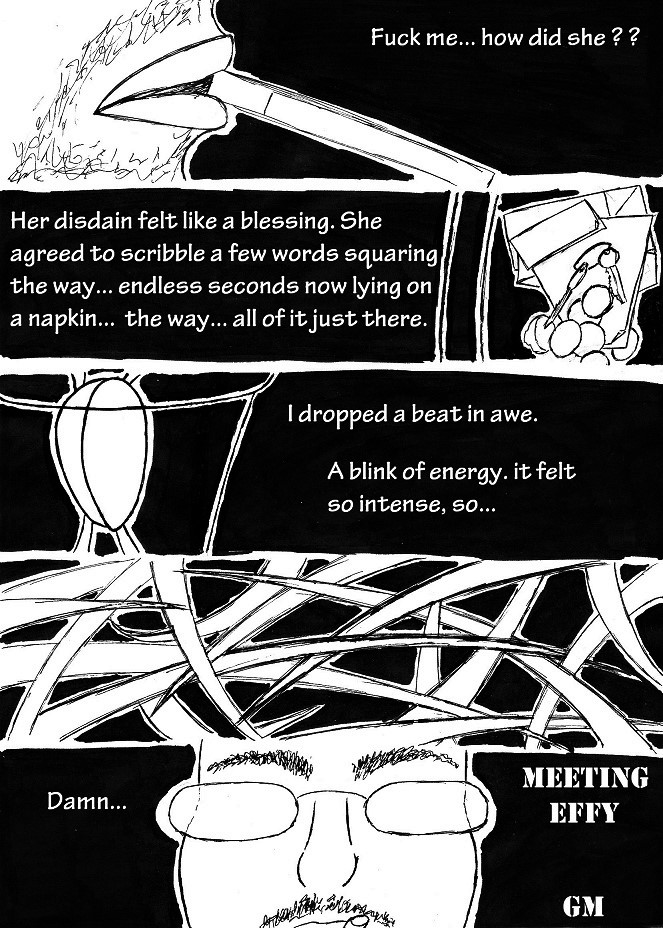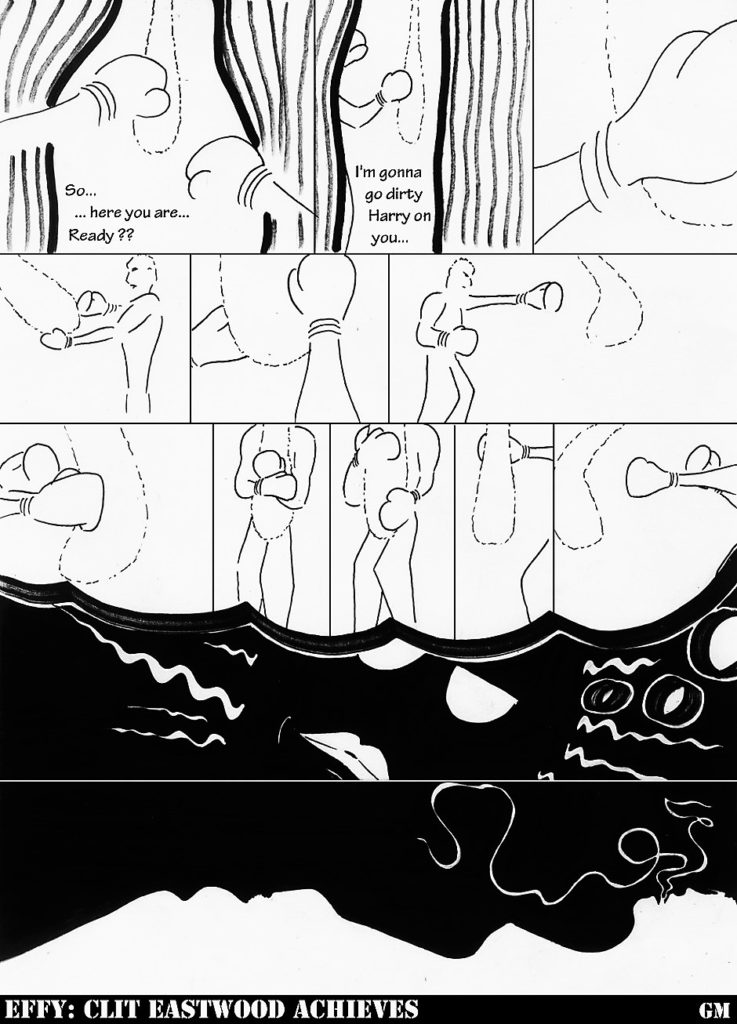G.M. must have rediscovered block printing, with four episodes resolutely celebrating ink and suffocating light! In this batch of new Effy -The living efficiency episodes, G.M. invites non business themes to play with Effy… inspiration, world population (with a return on Bio-Synergy), orgasm and degenerating disease… If that’s not an eclectic program, then what is!
Don’t miss his weekly updates on Effy’s own page or through Tapas!
Inspiration and efficiency
Efficiency is a very vaporous concept, one that is very hard to grasp and measure, but that inspires everyone. A lot of people, organizations and institutions tried to create indicators to measure efficiency. For example, financial efficiency generally use monetary terms for measurement. Production efficiency can be measured through a wide variety of kpis depending on the industry (production efficiency here is not to be misunderstood with productivity, and Process Street made a great article to highlight differences). Energy efficiency, work efficiency (formula from Sciencing), process efficiency (a full study by Business Entreprise Mapping using Total Process Efficiency theory here), time efficiency, and so it goes. Even online social efficiency can now be measured by a ratio of likes received for likes given…
Most of the time, these indicators only focus on one aspect of efficiency, and use a limited amount of factors. As seen before in “Humanitis” episode, efficiency often contradicts itself. For example, a factory spilling oil waste and polluting a river instead of treating it is financially efficiency. However, this action is very inefficient for the whole area, that will have to start importing food they can no longer grow.
Developing a wide range of specific indicators is a very logical approach, considering that efficiency heavily depends on your perspective. However, I believe that true efficiency does exist. We’re entering slightly into the field of faith here, but an over-encompassing efficiency that would be so… efficient… that it leaves everyone in awe, without doubt about its existence, and wondering how this could be possible. A feeling similar to love; an inspiration…
So today’s story was just that, someone meeting true Effy…
World population pressure on resources
Bio-Synergy II is the second part of Effy’s reflection on reproduction after Bio-Synergy. Effy being a heartless concept, her solutions might appears rather… drastic.
Earlier this month, The Lancet issued a new study “Fertility, mortality, migration, and population scenarios for 195 countries and territories from 2017 to 2100: a forecasting analysis for the Global Burden of Disease Study“. They projected that world population will peak at 9.6 billion, before declining back below 9 billion by the end of the 21st century. Such trend is substantially below previous projection.
Forecasting so far ahead, on a subject with so many variables, necessarily impose a wide series of hypothesis. However, what everyone seem to agree with, is that population will continue to increase for the coming decades. The resulting pressure on core resources (eg water or energy) already is, and will remain, a major challenge for humanity.
Further reading: Thought Co’s Current World Population // Country Meters // World O Meters
Output based and Straight efficiency
Today is all about straight efficiency, an output based efficiency analysis. As defined before, efficiency is the ratio of desired outputs per inputs. To analyze and measure the degree of efficiency of let say a process, three main approaches can be observed: Input based / Output based / Mixed.
The omelette example
Financial efficiency being the easiest type of efficiency to measure (since all factors can be measured in monetary terms) can provide for easy example: to generate 1 unit of currency, how many unit of currency does the process use? So, I plan for tonight’s dinner: mushroom omelet + salad.
Output -> a dinner valued at 90 (value include nutrition value and pleasure), rubbish (eggshell) and smoke valued at -10 = 80.
Input -> raw materials (eggs 10, salad 10, dressing 10, mushroom 10) + cooking an cleaning time (20) + cooking tool usage (depreciation value of 5) + cooking energy (5) + location usage to eat (5) = 75.
Financial efficiency (we’ll use profit ratio for simplicity): (80-75)/75 = 7%.
Analyzing efficiency
- Input based:
Which are all approaches analyzing and measuring amount of useful and indirect resources used in a process to obtain one unit of desired output. Input based approach will focus on inputs, with a series of cost analysis, optimization, and cost reduction actions.
Benchmarking (is 20 for a cook at market rate level; is 40/75 for RM an adequate ratio; is…); sourcing & negotiation (what if we source eggs from a farmer and not supermarket to reduce intermediaries markups? what if we include more supplier to compete?); resource replacement (what if we replace mushroom by a cheaper type of mushroom? what if we recycle previous day’s dressing leftover instead of doing a new dressing? what if I had my kids whose time I value less do the dishes instead of me?); process change (what if we bake the omelet instead of frying it to save on tool usage?).
Input based approach assume outputs value remain relatively stable.
- Output based:
These are all approaches focusing on outputs. To trail our example, this would lead to price and quality analysis (is 80 a fair value? can it be more by increasing quality without adding resource? can it be more if I had educated my daughter to like eggs?); byproduct valorization (can eggshells have any remaining value?); waste reduction and recycling (can smoke and dirty plates be limited? can we recycle leftovers?).
Output based approach assume input remain relatively stable.
- Mixed approach:
Here you play on both inputs and outputs equally: volume impact (can I get economies of scale by making 5 omelette today instead of just 1 to cover dinner for the rest of the week? would that affect value of my dinner?); marketing and selling (what if I had an extra 5 of my time to promote my omelette to my kids, creating stories around the magical benefits of eggs, so that the value of the omelette can be increased by 10?); product change (what if I add ketchup and draw a smile on the omelette? or what if I switch to fries instead?). And it goes…
There’s nothing right or wrong with any of these. In reality, with complex processes need full analysis.
What about straight efficiency?
Straight efficiency is an output based approach, focusing on optimizing the output using stable resources. This is basically what Effy Creations is all about somehow and the topic of “Ambitious output / basic input” or “Effy’s effy recipe“. The objective is to increase the efficiency of a process / service / organization by increasing the value of the output without modifying the input. This has been the essence of diy, punk, and so many artistic movement, yet is seldom seen in the business world that dislike its non marketable simplicity.
Well in this episode, Effy definitely goes for straight efficiency: with stable inputs (fingers), she refined her own technique for the most straight and direct way to accomplish ecstasy, and she went Dirty Harry…
Memory and efficiency
This week, we review the role of memory in efficiency, and impact of ageing / failing memory over efficiency. Now, how to link memory with efficiency? At least in two ways, for one memory acts has a support of efficiency, and second memory helps to value results.
Memory as process accelerator and source of efficiency
As we experience life, our senses carry a load of feelings through our body. These batches of emotional experiences are stored in our memory. As we walk through life, our memory will then be triggered every time we need to retrieve these batches of knowledge. By doing so, memory acts as a support to speed up our day to day processes.
Example: I vomited after eating an awful shepherd’s pie when I was 6 at my school canteen. Now when I see a shepherd’s pie, my memory has created a go-to shortcut with my body to make sure than without a second thought, I avoid eating it. The outcome of: “shepherd’s pie is bad” comes faster. Memory has made my decision making faster, qualitatively constant and overall more efficient.
Memory as result assessor and auditor of efficiency
Efficiency only matters if the process’ resulting outcomes matter. Better said, if the value derived from outcomes is greater than the sum of inputs’ value. Financial efficiency aside, raw efficiency in itself is hardly measurable (as seen in humanitis) because it heavily depends on factors at stake. So we assess and evaluate the world around us through empirical comparisons.
To do so, we benchmark against our knowledge, stored in our memory. Let’s keep the shepherd’s pie example with the following question: what is shepherd’s pie flavor efficiency? Better said, has flavor improved going through the shepherd’s pie cooking process? My brain will assess flavor of raw potatoes against other ingredients based on previous memory I have, and so on with all ingredients that makes a shepherd’s pie. I’ll then assess the flavor of the shepherd’s pie, and compare with memory I have of raw ingredients’ flavor. This is the perfect example of an non measurable efficiency. But to me, the flavor of shepherd’s pie is worse than a plate of raw meat (carpaccio) and raw potato (raw potato I secretly tasted behind my mum’s back).
Some could argue this all result from a bad cook… maybe, but even so, the point here is to say that memory helps to assess the value of an outcome. So if I were to taste another shepherd’s pie from someone else, I’ll then compare it with my memory of the first one, and of the sum of ingredients. The point remains valid.
Memory, and its many batches of comparable alternatives, serves as an assessor of efficiency. It allows bench-marking the value of intrans and outcomes, for factor that are too hard to measure.
Memories’ flaws
Unfortunately, despite such a central role for efficiency, memory has many flaws, that directly impact the way we perceive efficiency. Memory is selective. It’s unstable and never complete. Worse of all, memory ages… So what it means is that:
1. we must review every now and then all go-to shortcuts created by memory, to ensure that they remain optimal. That mean questioning yourself and your automated reactions. For example, I used to hate peas too, until I ate an amazing Indian dish with peas. So maybe my taste about shepherd’s pie I no longer accurate, and I shouldn’t escape the next shepherd’s pie.
2. my empirical ruler to value the world around me is intrinsically flawed, and will become more and more flawed, so I should be humble enough to ponder all my empirical assessments before judging any process true efficiency.
Ageing memory sucks…
So yeah, memory being so vital for an optimal efficiency, contemplating memory’s decline (through ageing, disease or lack of new experience and practice) sucks… and what better way to illustrate than good old suckers: vampires!












